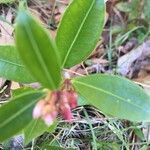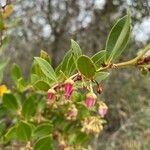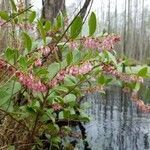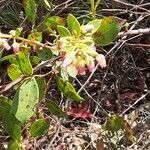Shrubs, to 2.5(-5) m. Stems erect to arching, usually sharply 3-angled. Leaves persistent; blade narrowly to widely elliptic, obovate, or slightly ovate, 1-8.5(-10.5) × 0.5-4.5(-5.5) cm, rigidly coriaceous, base attenuate or cuneate to rounded, margins entire, usually revolute, apex acuminate to acute, rarely rounded, surfaces scattered, multicellular, glandular short-headed-hairy, not lepidote, otherwise glabrous or hairy on midvein adaxially, intramarginal vein present. Inflorescences fascicles, developing from buds along distal portion of stems of previous year; bracts 1 per flower, linear-lanceolate, to 4 mm. Pedicels glandular-hairy, not lepidote. Flowers: calyx lobes 2-7.5 × 1-2 mm, glandular-hairy, not lepidote; corolla usually pink, sometimes white or red, cylindric (base swollen), 5-9 × 2-5 mm; filaments 3-5 mm, roughened, with 2 well-developed spurs. Capsules ovoid to ovoid-globose, 3-5 × 3-5 mm, apex slightly constricted, glabrous or short-headed-hairy; sutures usually remaining attached to adjacent valve; placentae central to nearly basal. 2n = 24.
More
Evergreen shrub to 2 m; lvs leathery, glossy, elliptic to narrowly obovate, 3–7 cm, acute or abruptly acuminate, entire, with a distinct intramarginal vein; petioles 2–5 mm; sep oblong, 3–5 mm, persistent; cor 7–9 mm; stamens with a pair of ± well developed spurs near the junction of the anther and filament; fr subglobose or depressed, 5 mm thick; 2n=24. Wet woods; se. Va. to Fla. and La. May. (L. nitida; Neopieris n.; Desmothamnus l.)




